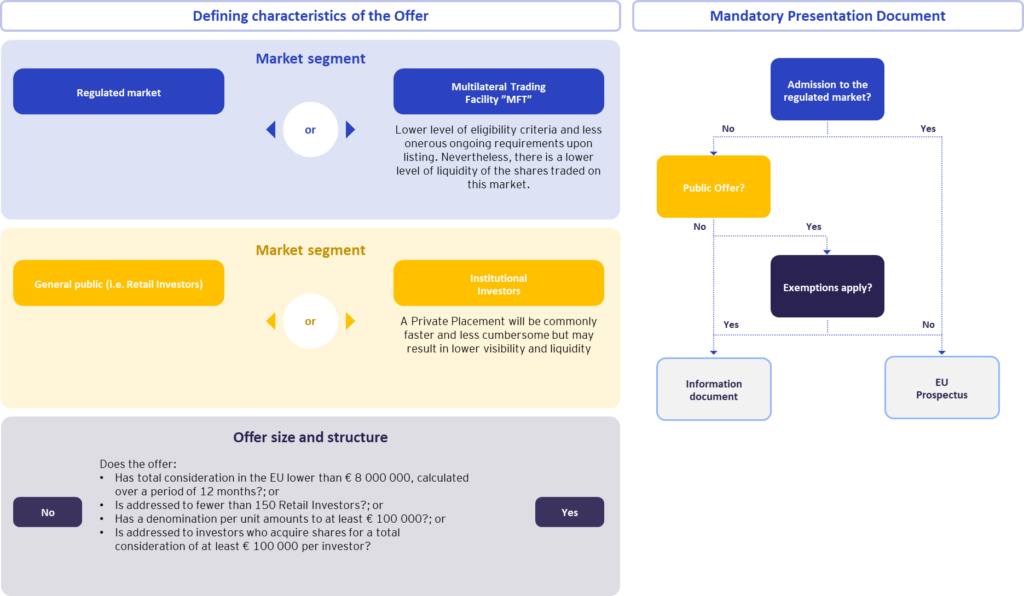Last updated:
A regular Bond Offering process typically requires smart preparation. The level of demand and planning for a Bond Offering is dependent on stage of the Company’s development, on the characteristics of the transaction – the format of the offer prior to the listing (“the Offer”), the market of the listing and also on the type of presentation document that will be required to prepare and disclose to investors or any additional documents that the Company may wish to disclose.
The presentation document can be Prospectus drafted in accordance with the EU legislation (“EU Prospectus”) or an Information Document/Technical note and aims to support investors in making an informed decision on whether to invest in the Company’s bonds. Accordingly, it is necessary to ensure an adequate transparency to protect potential investors.
The preparation of an Offer addressed to the general public (“Public Offer”) that has as a presentation document an EU Prospectus is more challenging than it would otherwise be for an Offer that only requires the disclosure of an Information Document, as a counterbalance to reach more investors and liquidity.
Drafting a Prospectus may be more demanding but not necessarily a burden: The Prospectus will be subject to approval by the CMVM, which provides the proper support, since early stages of the preparation process, to potential new issuers. The CMVM (or Regulator) performs streamlined and agile procedures for reviewing and approving Prospectus, as a part of its goal to support the development of capital markets.
An EU Prospectus may benefit of a higher level of confidence from the investors.
In certain circumstances the preparation of an EU Prospectus is a mandatory requirement for the Offer. The main characteristics that determine the need to prepare and disclose a Prospectus are:
Recommended reading: 4.1.1.2.3. Prospectus – further information on the presentation documents; 4.1.2.2.1. Presentation document – further information on the presentation documents.
Market segment
You might choose to list your bonds on a regulated market or on an MTF.
The regulated market has the higher level of eligibility criteria and more demanding ongoing requirements upon listing, given that is the segment that provides more liquidity and may attract more interest from investors, both institutional and retail. It should be noted that beyond the enhanced visibility provided by regulated markets, some Institutional Investors have investment policies that require to invest in regulated markets exclusively.
Alternatively, the MTF segments have lower eligibility criteria and less onerous ongoing requirements upon listing but may provide lower liquidity.
Recommended reading: 4.1.1.1.2. Eligibility criteria – information on the eligibility criteria for each segment and section; 5.2. Ongoing Regulatory Requirements – requirements for each segment.
Targeted investors
You may choose to offer your bonds to the general public (i.e. by pursuing a Public Offer) and/or to Institutional Investors (i.e. by pursuing a Private Placement). A Public Offer reaches a wider pool of investors and enhances the Company’s image but may require a longer and more demanding preparation. Alternatively, a Private Placement will be commonly faster and less cumbersome but may result in lower visibility and liquidity.
Besides the exceptions that will be presented next, if you choose to pursue a Public Offer you will have to prepare a Prospectus. If you choose to pursue a Private Placement and a regulated market is chosen for listing you will also have to prepare a Prospectus, but simpler and more concise. Finally, in case of a Private Placement and listing in MTF you need to prepare an Information Document.
Offer size and structure
The Portuguese and European legislation provide exemptions for the need to prepare and disclose a Prospectus for Public Offers.
A Prospectus will not be required for a Public Offer if any of the following applies:
SMEs and other companies meeting some criteria, may choose to draw up EU Growth Prospectus, a more simplified and concise Prospectus.
Recommended reading: 4.1.1.2.3. Prospectus.
Considering the referred elements, these are the different assumptions according to which a Prospectus may or may not be required:

In view of the above, the section ‘4.1. Full Scope Bond Offering Process (Bond Offering with Prospectus)’ explains the typical Bond Offering process and its main steps in case a Prospectus is required. In section ‘4.2. Simplified Scope Bond Offering Process’ we will present the main differences of the offering process when no Prospectus is required and the admission to trading is requested on an MTF.

